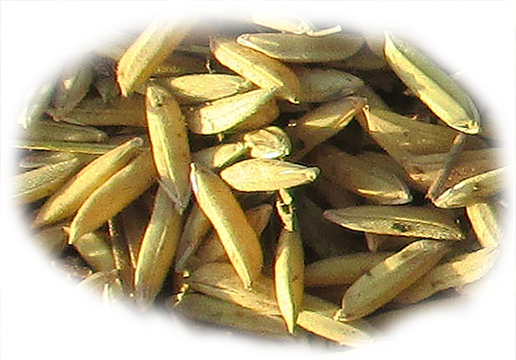
1.
Rice in Southeast Asia
After homo sapiens spread out in prehistorical times from Africa into the different world regions on most of the globe's continents, at certain points of it's development most groups became sedentary. Sedentariness went along with the cultivation of different grass sorts as a basic food supply. In Meso America it was corn (maize), in Mesopotamia wheat, in Asia rice. According to a research in 2012, the first domestication of rice (Oryza sativa) happened in the Perl River Delta in China between 8,200 and 13,500 years ago. The technology spread out from there first within China and then, at the end of the 3rd millennium BCE, to Southeast Asia.
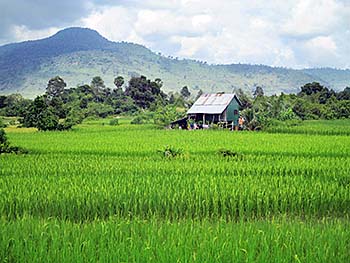
Rice paddies with peasant shack in Cambodia at the foot of Bokor Mountain. Image by Asienreisender, Kampot, 11/2016
There is no evidence for an independend development of rice domestication in Ban Chiang, Thailand, although it could have happened. For Cambodia, scientists date the application of wet rice cultivation 5,000 years back, a technology coming from South China.
Rice farming and the implementation of a large-scale irrigation system was the basic condition for the emerge of any civilization. The classical empire of Angkor grew so big only due to the highly sophisticated canal system and the construction of it's capital as a hydraulic city. Angkor Thom was for a time the largest preindustrial city in world's history; the Angkoreans could harvest up to four times per year. The contemporary Khmer are down to one harvest a year, far behind compared to the middle-ages.
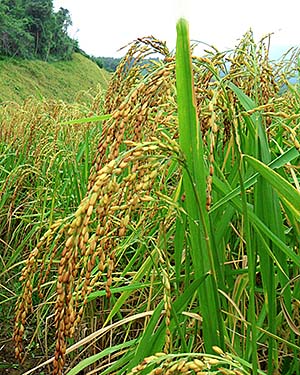
Rice blades on the field, almost ripe. Image by Asienreisender, Chiang Khong, North Thailand, 10/2011
Nowadays, rice is the main basic food in all Southeast Asian countries. More than half of the world's population eats rice as it's basic food. Asia is the main producer of rice, particularly China. 95% of the worlds rice production comes from Asia. Indonesia is the third biggest rice producer, other Southeast Asian countries like Vietnam, Thailand, Burma/Myanmar, the Philippines follow close. Thailand and Vietnam are the largest rice exporters in the world.
In Thailand alone grow around 3,500 different kinds of rice, depending on local specifics like altitude, weather, temperature etc. The main export kind is white jasmine rice 105.
In Thailand, rice sales are a state monopoly. The government buys rice for fixed prices and gives licenses for the export. The revenues are meant for large, state financed irrigation projects and research for the improvement of productivity like fertilization and pest prevention. Former primeminister Yingluck Shinawatra (2011 - 2014) was sued after the May 2014 coup de etat by the now ruling military regime for allegedly having abused the rice scheme.
Rice production in Southeast Asia happens on the many petty estates of peasants.
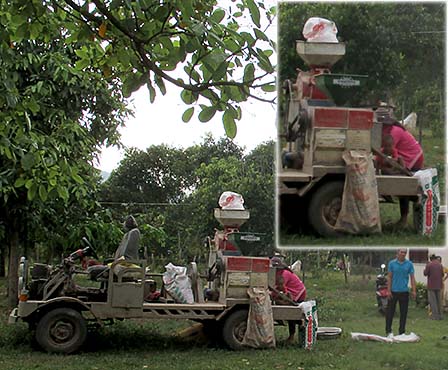
The vehicle goes through the peasant neighbourhoods and mills their rice small-scale. Image by Asienreisender, Kampot, 12/2016
Traditionally, labour on the rice fields is community work. 90% of the world's rice is produced without any mechanization, the remaining 10%, in the developed countries of South Europe and the USA, are highly mechanized by the use of planes for seed planting, fertilization and pest- and weed killing and the application of big harvesters.
The most valuable content in rice is contained in the silver hull. There are several vitamins like B1 (thiamine), B2 (riboflavin), B3 (niacin), B5 (pantothenic acid), and B6 contained. Among the minerals are calcium, iron, magnesium, manganese, phosphorus, potassium and zinc. Most of the calories lie in the carbohydrates (up to 80%), while proteins make maximal around 7% and far less than 1% fat is contained. People who eat mostly or exclusively rice suffer food deficiencies. Vitamine A deficiency is a very common appearance in so called 'developing countries'.
2.
Wet Rice Cultivation
Originally, rice is not a water plant. Only after an adaption over thousands of years, sophisticated wet rice sorts were bred artificially. There are several advantages for wet rice over dry rice. The annual floods due to the monsoon get an integrated part into the rice production circle. Many kinds of weeds and crop pests don't drive well in the water. There is a significant difference between rainfall farming and irrigation farming. 80% of the world's rice production is based on wet rice farming. The water is not standing but in a steady, slow flow. For a kilogramm of rice, between 3,000 and 5,000 liters water are required. If the water flows too slow, algaes grow and harm the plants; does it flow too fast, nutrients flush out.
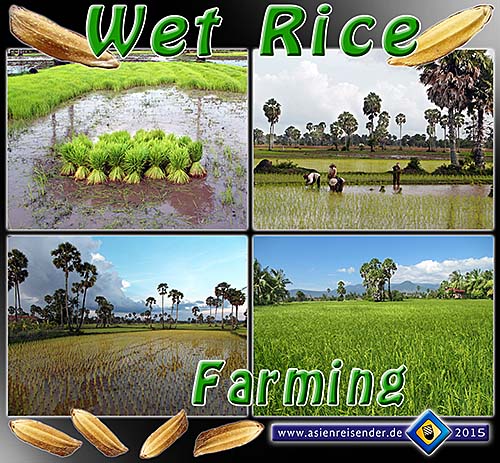
The seedlings (top left) have been brought from another field and are now transplated into this one. After that, most is depending on a slow but steady water flow. Unfortunately are often dangerous insectizides used, who poison the water and the rice. Images and photocomposition by Asienreisender, Kampot, 2014, 2015
However, here and there one sees also dry rice farming, particularly in mountainous regions like in North Thailand and North Laos. Dry rice farming requires more labour.
Most of the rice sorts in Southeast Asia are wet rice. Practically most of the rural landscapes are coined by rice paddies. In practice, the cultivation looks like that: The first step is the seeding into mildly watered soil (here it becomes evident that rice is not an original wet plant, for the seeds wouldn't grow in the water. The fields have to be ploughed then, traditionally with water buffalos, nowadays more and more with tractors. Third, after some weeks, the seedlings have to be transferred from the plant field into the rice paddies. The growth now depends much on the irrigation. Problematic is if there is not enough rain or other water supply, or if there is too much rain who floods the fields.
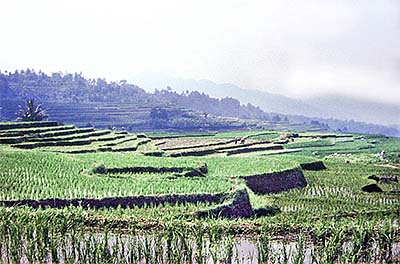
Rice terraces in West Sumatra. The water is sophisticatedly channelled in a pattern that it passes over a long way through many rice paddies. As steeper the terrain goes, as smaller are the paddies. Image by Asienreisender, 1996
Traditionally, in these wet rice fields live a lot of small fish (like guppies), crabs and other water animals. They do a good job in pest reduction and eating mosquito larvaes. Due to the (often massive) use of pesticides, these useful animals die, often get completely rooted out. After some four to six months, at the end of rainy season, the paddies get dried out and harvesting happens, often with small hand sickles. The rice get's bundled and threshed. The rice straw get's burned on the fields and contributes to the heavy air pollution in Southeast Asia during the dry seasons.
Wet rice cultivation creates an oxygen-poor habitat in the soil which is a hotbed for anerobic bacterias who produce methan gases. 17% of the global methan is spawned on the world's wet rice paddies, alltogether 60 million tons. Methan is more than 20 times as driving towards global warming than carbon dioxide (CO2).
Rice farming consumes roughly a third of the earth's fresh water.
3.
Processing
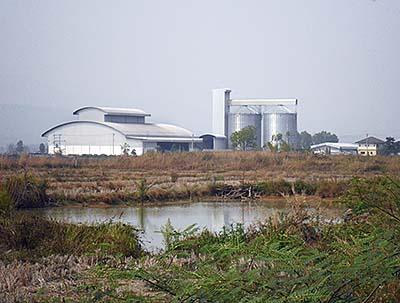
A larger, industrial rice mill. Image by Asienreisender, Chiang Khong, north Thailand, 2/2012
The rice corn from the halm is unedible. After the harvest, the rice get's first dried. The dried product is then called paddy-rice. The drying for the self-consumption of the peasants happens often in front of their houses on large blankets.
In a rice-mill, the rice gets dried, either by sun or artificially or both. The drying has to go quickly to avoid fungus. Simple mills merely remove the husk, but the big, industrial mills who appear more and more, process thousands of tons polished rice a day.
4.
Parboiled Rice
Husked rice looses almost all of the best ingredients, the vitamines and minerals, who are concentrated in the peel. The parboiled processing (stands for 'partially boiled') saves about 80% of the valuable content (minerals and vitamines). The rice is set under water for short and then processed under hot steam.
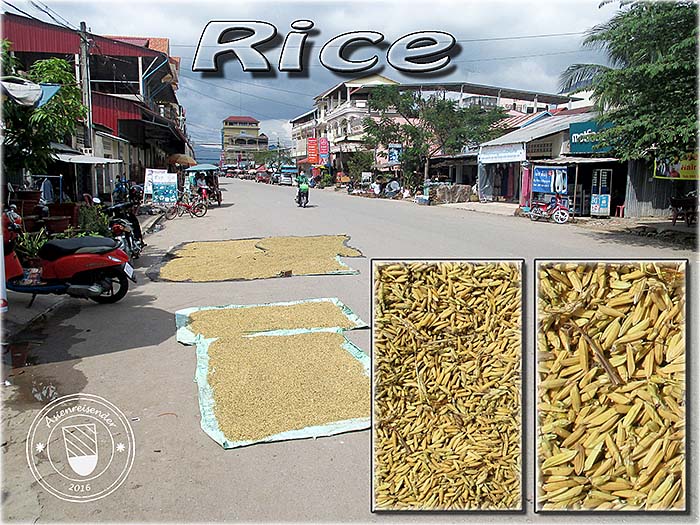
Often enough, rice is just laid out on the open roads for drying in the sun. That's for self-consumption within neighbourhoods. Images and photocomposition by Asienreisender, Kampot, Cambodia, 11/2016
5.
Dishes and Drinks
A very famous and delicious kind of rice is sticky rice. It's a regional cuisine particularly in Isan and Laos, also wide-spread in North Thailand. The rice is prepared for a few hours in water and then processed with steam.
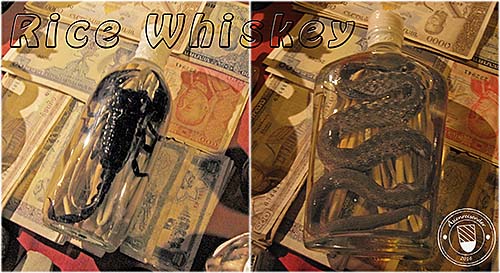
R ice wine or rice whiskey bottles on the evening market in Luang Prabang. It's an old, strange custom to put a dangerous animal like a snake or a scorpion inside. There are certain beliefs that mysteriously power of the animal is somehow transferred to the consumer. Image by Asienreisender, 2006
Fried rice (like nasi goreng in Indonesia) is a standard dish in Southeast Asia, which appears on any menu in the restaurants. As a breakfast dish, rice soup is a common dish in Laos and Thailand; that's rice with much water and vegetables, together with chicken or fish.
Also the Southeast Asian noodles mostly base on rice, not on wheat. The same is certainly to say concerning the baguettes in the countries of formerly 'French Indochina' - rice flour, not wheat, is used to make them.
Famous is also rice whiskey or rice wine, lao-Lao, lao-Thai. It's cheap, because peasants can brew it themselves in their kitchens; however, sometimes the alcohol is not good and can cause health damages. Also beer can be brewed with rice.
A famous and tasty rice from Thailand is jasmin rice, a sort which is cultivated in Isan (and partially also in Laos and Vietnam). It smells for Jasmin and has, in difference to other kinds, a certain taste. Another kind is Thai red rice, called Red Cargo Rice, a longcorn rice.
6.
Threats, Pests, Health Concerns
Rice pests are often fungi. An number of other plant diseases is virulent. In granaries the rice can be threatened by rice beatles (Sitophilus oryzae). The beatle's larvaes grow in the rice corns and eat it from within. There are other for rice harmful bugs as well.
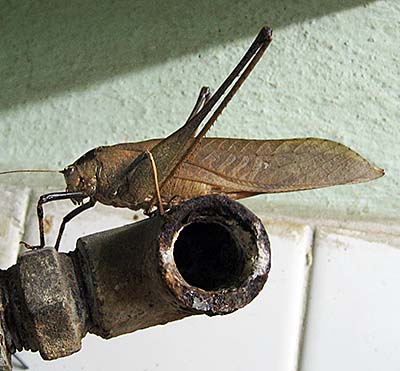
Appearing in great numbers, they become a crop pest. Image by Asienreisender, Prachuap Khiri Khan, 10/2006
Moreover, weeds, rodents, birds, a number of pathogens and insects like grasshoppers and worms potentially harm rice plants. Climate change and improper irrigation can trigger pests and harvest losses.
Another issue is the contamination with arsenic. In Thailand and Cambodia the water is to a higher degree than in most other countries contaminated with arsenic, and the poisonous half-metal enriches in rice ten times as much than it does in other grain sorts. Arsenic can cause cancer.
It's possible that rice, after being boiled, contains Bacillus cereus spores, who spawn an emetic toxin in warm and lower temperatures. To preserve boiled rice for next days consumption, it's therefore recommended to put it into a fridge with a temperature below 4 degree celsius. Reheating, like frying the rice again, would kill the bacterias, but not neutralice the toxin.
Directly after the financial crash of 2007/2008, world market's rice prices grew considerably, about 75%. Droughts and export reductions where two triggers. Food speculation is another major factor, the poor, 'suffering' banks and hedge fonds ned new markets for the generation of profits. The destruction of large areas of acreage for industrial purposes and urbanization, including golf courses for the rich, contributes also to the reduction of rice production. Acreage for rice is also changed in grand style for the production of the officially so promoted 'bio'-fuel. The precious cars, one of the major fetishes of modernity, need also food. Cars eat men. Rising food prices are a major risk for political stability in many countries.
7.
Scientific Improvements
A relatively new production-method for rice was invented by Henri de Laulanie in Madagascar (around 1983). SRI (System of Rice Intensification) allows greater productivity by a reduction of water, seeds and fertilizer. It's based on a symbiosis between the rice plants and aerobic organisms.
To solve the problem of lacking vitamin A, a genetically modified rice sort has been invented. The rice can generate beta-carotine, a substance which allows the human body to produce vitamin A from. Since this rice sort gains, after procession, a yellowish colour, it's called 'golden rice'.
Another development is the identification of a rice gen which allows rice to survive for two weeks under water (instead of one week as usual). A gen-manipulated rice sort of that kind would be much more resistent against floods (more weather extremes are one of the effects of climate change). The opposite way is the development of drought-tolerant sorts of rice, who are designed for areas with periodically (or potentially) lack water over times.
Salt intrusion is a large problem in many coastal areas. A striking example is the industrialization of the Mekong River, which leads, together with the rise of sea levels, to salt intrusion in the Mekong Delta. In this large, fertile area lies the main acreage for rice in Vietnam. Rice sorts with a much higher salt tolerance than usual are under development. However, a breakthrough can not be expected before the coming years.
8.
Peculiarities
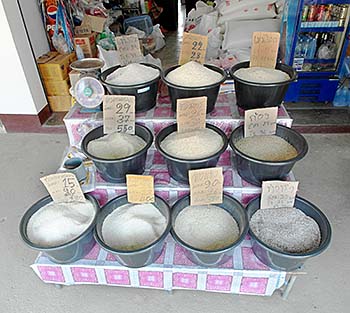
A variety of different rice sorts in a shop in Chiang Khong, North Thailand. Image by Asienreisender, 3/2013
Rice as the basic food plays a central role in the culture of many Asian countries. In Thailand and Laos for example the word for rice, 'khao', means also food, 'gin khao'. In Cambodia I have been asked sometimes if I ate rice already, what is the equivalent for the Western 'How are you?'. In Thailand a deity called Mae Posop is revered as the mother of the rice harvest.
9.
Sources
This article is based on decades of practical experiences and observations. Moreover it's based on a number of publications. You find a list of them on the Literature page. However, it's not at all exhausting; it comes together with uncounted articles from newspapers, magazines, (qualified) websites and movies, both fiction and documentary. Sometimes, a good talk with a connoisseur of a certain topic provides me with facts, ideas, inspirations and innovations and/or reveals a mistake or two.

Harvest time is at the end of rainy season. Soon later the paddies, formerly under water over months, now dry out. The soil gets bone dry and hard. Often it's a clay ground. The remains will soon be burned, causing smog. Image by Asienreisender, Kampot, 1/2014